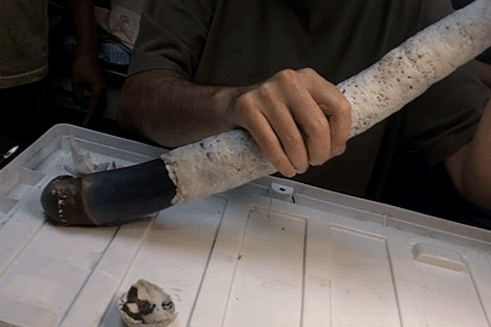That image above, depending on what your job is, could well be considered not safe for work. What you're looking at is a giant shipworm---a scientific legend that can grow to over five feet long. It's actually a super-elongated mollusk, one that grows vertically in sediment, excreting a thick shell and poking two siphons out of the muck. It is, as biologists note, really weird.
Such biologists have long known what made these tusk-like shells, but couldn’t manage to get their hands on a live animal. Until 2010, when a scientist watching Philippine TV happened to catch a documentary about the men who dive for the things, and was finally able to track them down. Where in the Philippines, exactly, will remain a secret. The shells can fetch $200, so in the interest of preserving the species, marine biologist Daniel Distel and the other scientists who write about the critter today in the Proceedings of the National Academy of Sciences are withholding the location.
You may have heard of the shipworm before. It’s a pest, if we’re being honest---it bores through wooden boats and mucks up piers. It maxes out at two feet long, but is far, far skinnier than its girthy cousin. So why on Earth would the giant shipworm grow so much bigger? That was a mystery decades in the making---and one that scientists can finally answer with their specimen in hand.
Before he ever had a living specimen of the giant shipworm, known formally as Kuphus polythalamia, Distel had a theory. Your typical shipworm gnaws through wood, but can’t digest the stuff on its own. So its gills hold special bacteria, which produce enzymes that then move into the gut to break down the wood’s cellulose into sugars for easy digestion.
Maybe, Distel reckoned, the giant shipworm is somehow making use of the plentiful decaying wood in the shallow waters of the Philippines. Maybe it lived like an earthworm, hoovering up mud and filtering out the organic material. “That seemed reasonable, but when we found that the bottom of the tube was closed, that seemed to sort of contradict that idea,” Distel says. What would the giant shipworm do with all that waste it’s producing if the end of its tube was sealed shut? Earthworms, after all, take in a whole mess of dirt and fire it out the other end.
How about filter-feeding, then? Perhaps the giant shipworm is using those exposed siphons to pluck plankton out of the water. “But we don't think that's a major part of their nutrition,” says microbiologist Margo Haygood, a co-author of the paper, “since almost the entire body is filled with this big gill and all their digestive organs are very reduced.”
That big gill is a big clue. Perhaps like deep-sea tube worms clustered around hydrothermal vents, it’s using special bacteria not to break down wood, but hydrogen sulfide. This rank compound pours out of such vents, and is also in abundance in the rotting mud of the Philippines.
When Distel opened up the first living specimen and got inside that huge gill, he found bacteria, just like in a typical shipworm. But when he and his colleagues sequenced the bacteria’s genome they found genes that other species of bacteria use to process hydrogen sulfide. So it appears that the shipworm takes in hydrogen sulfide, which the symbiotic bacteria synthesize into energy for the host.
That’s why the giant shipworm’s gill is so huge and its digestive system so tiny---the bacteria does the work, so a big gut isn’t necessary. “It's sort of like an evolutionary convergence,” says Haygood. “It's very similar in some ways to the giant tube worm at the hydrothermal vents. Most of the body cavity is occupied by this organ that's full of symbionts.” The giant shipworm grows so giant, then, because its environment---like the deep-sea vents---is at all times loaded with that pungent hydrogen sulfide, a food that other critters would never recognize as food.
How, though, could the giant shipworm so radically depart from its wood-eating cousins? A clue could be the giant mussels that call deep-sea vents home. In 2000, Distel discovered that a tiny variety of mussel---no bigger than a sesame seed---lives on the hydrogen sulfide that rotting wood produces, breaking down the compound with the help of symbiont bacteria. Long ago, a mussel like this may have sunk down to the hydrothermal vents to find a bounty of hydrogen sulfide, growing enormous in the process.
Maybe the giant shipworm evolved in much the same manner. “If an ancient shipworm acquired sulfur-oxidizing symbionts, then they would have an environment that contained both their typical diet of wood and hydrogen sulfide,” says Distel. “So it acted as an evolutionary stepping stone, allowing them to make that transition from eating wood to living on hydrogen sulfide.”
And so a massive mollusk mystery suddenly becomes clear. And a little bit stinkier, I suppose.

